The Fabulous Loop de Loop
THE PORTA PAK: SONY VIDEOROVER DV-2400 (1967) + SONY VIDEOROVER II AV-3400 (1970)
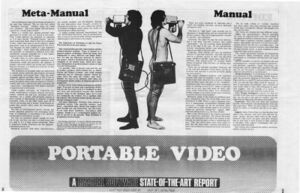
TOWARD THE PORTA PAK
[1]Video tape, which had been in development for decades before the introduction of the Portapak, emerged from the development of audio tape, sharing a lot of its technological and institutional history. Even before the development of video tape, video cameras were used by the military – early video cameras were used as part of a weapons guidance systems – and were also adopted by the broadcasting industries – there was a pressing need for instantaneous playback of sporting and news events.[2]
The main disadvantages for the development of video tape technologies had been two-fold: the amount of tape the system consumed and the fidelity of the image. To begin with, the amount of tape that fed through the machines was considerable (thirty feet per second in earlier machines) [3] but once the “quadraplex recording” design was adopted [4] the Ampex VR-1000, which became the TV industries machine of choice by the late 1950s, consumed only “fifteen inches of tape per second—or half an inch per frame—fitting ninety minutes of video onto a reel fifteen inches in diameter.” [5] This brought the machine closer to portability, but it was still, by current standards, colossal and inordinately expensive for general use [6]
The second issue, the question of fidelity of the image, was improved by allocating three functions on a two-inch thick tape. The larger part, running through the centre of the tape, would record the image and the margin at the top of the tape would record the audio, lastly a third track running at the bottom would contain the control data (regulating play back speed &c).[7]

By 1960 the Ampex VR-1000 had introduced a system which integrated the recording of audio and video and which would provide the technological basis for more flexible and portable technologies in the coming decade.[8]
The parallel development of videotape and video-recorders had been taking place in Japan, which in the 1950s had imported the American Ampex VR-1000 systems for use in their own media. The cost and the size of the tape was reduced by Norikazu Sawazaki, who worked for Tokyo Shibaura Denki (Toshiba). His system (1957) wound the tape round a drum in a helix shape (at an angle) making it possible to record the information diagonally. Sawazaki’s system required two tape heads instead of four and reduced the amount of tape needed still further. [9] The Japanese motivation to compete with the American Ampex system was fierce and by 1959 Toshiba, Sony, Matsushita, and the JVC (Victor Company of Japan) all had functioning prototypes of video systems – all of which incorporated a helix system similar to the one Sawazaki had devised. The sticking point for the Japanese companies was that the American firm Ampex held the patent for many of the components,[10] but when Sony developed a transistorised VTR (Video Tape Recorder) Ampex permitted its use for non-broadcast use in exchange for Sony’s transistorized components in Ampex’s equipment.[11]
The next significant stage in the evolutionary graph toward the Portapak is the Sony PV-100 (1961). This helical scanning, transistorised VTR weighed 145 pounds and could be carried by two people. The system could now easily be placed on a boat, train or plane and was used outside of a “mass media” context, for instance as military training equipment and as inflight entertainment on commercial flights.
The Astrovision was a PV-100 built into the bulkhead at the rear of the American Airlines plane’s flight-deck . [12] By 1962 Ampex had developed the VR-1500 system, “small enough to be transported in the trunk of a car.” They suggested it could be used for educational purposes “[…] ideal for transmitting previously recorded educational programs over closed circuit systems and providing instant playback of ‘role playing’ and other classroom activities.” [13]
In 1963 this system was incorporated into the Ampex Signature Home Entertainment System (an elite media package exclusively offered through one department store). This move toward domestic consumption was countered in 1965 by the Sony TCV-2010 Videocorder, which was touted by Sony as “tape yourself TV”. This promise of easy access and personalisation, a closed-circuit system that provided the possibility of real-time engagement and instant playback, bringing us into the realms of self-produced media. Such technologies established a new political and cultural horizon for countercultural initiatives such as The Raindance Corporation and the magazine for “video freeks” Radical Software, but these systems were still beyond the pocket-book of the average American media-artist.
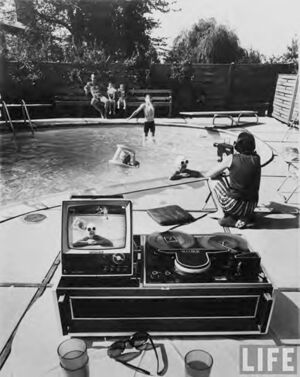
In October 1965 the Korean artist Nam June Paik, with money from the John D. Rockefeller III Fund, bought a Sony TCV-2010 from the Liberty Music Shop in Manhattan. He immediately set to work, filming Pope Paul VI, who was visiting the United Nations, through the window of his taxi. June Paik played the tape at the Café Go Go in Greenwich Village that same night. “[A]s collage technic replaced oil paint, the cathode ray tube will replace the canvas” he declared at the time. This was a few months after Andy Warhol had received the rather more cumbersome Philips EL 3400 (weighing in at 100 pounds) as a promotional gift from the company. In Warhol’s’ 1965 film Outer and Inner Space we see Edie Sedgwick talking to her own video image. It is an early recording of the unnerving bodily experience of “telepresence” – whereby the subject apprehends themselves as other and the audience, by extension, is caught in the circuitry of identification. Almost as an artifice of the apparatus, in this early film-video work the element of feedback seeks to destabilise the integrity of the subject. You may remember Lacan’s fantasy of the cybernetic tortoise, where two machines are frozen in apprehension of the self in the other[15] so Sedgwick is caught in a moment of self-apprehension as other – caught in an intersubjective circuit. This decentering of the self could also be read through the lens of Gregory Bateson, to be removed from ones self and to be at the same time present makes one aware of the different levels of abstraction the self is constructed within. Could the video system which abstracts the real-time self and repositions to outside the body also be seen as a technologically advanced Structural Differential? Hasn't this subjective circuitry (the fabulous loop de loop) been a feature of feedback machines since the Vapour Engine? Isn't this an artefact of any feedback machine, which causes us to question the nature of consciousness and through its presence in the world (as a vapour engine, second-guessing computer or cybernetic pet) challenges our notions of how the self is constituted?
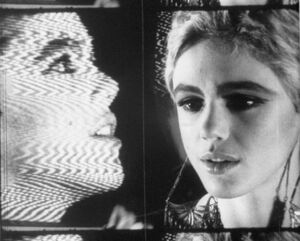
Sony’s battery powered VideoRover DV-2400 followed in 1967. The recording unit now weighed eleven pounds, with the camera weighing five. The system recoded on 20-minute CV video reels. This was the first of the “portapaks” – a generic name for the portable video systems produced by Ampex, Sony and Philips in the late 60s and early 1970s. The most successful to emerge was the Sony VideoRover II AV-3400 (1970) which recorded on 30 minute tapes and also afforded instant playback through the camera itself or through a monitor, it carried a standard format, EIAJ Type I tape which could be used on other brands of machine, and perhaps most importantly, it retailed for $1495.[16]
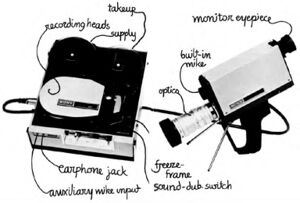
Although variously used as a training tool, an educational aid, in the broadcasting industry and as a surveillance system in business, portable video equipment was about to find a new application in a cultural artistic revolution which embraced ecology, media, aesthetics, which will all refracted within this mirror of subjectivity, the portable video system.
THE DOUBLE BIND – FAMILY THERAPY –TOWARD A MEDIA PSYCHOLOGY
To briefly recap: In Alfred Korzybski and Gregory Bateson – Why “The Map is NOT the Territory we learned that Korzybski argued that the etiology of schizophrenia was due to a confusion of levels of abstraction. Korzybski maintained that the schizophrenic confused the concrete and the abstract (the map for the territory). Korzybski identified this with reference to Alfred North Whitehead and Bertrand Russell’s Theory of Logical Types. Korzybski built a plastic diagram, the Structural Differential, as a therapeutic aid for those who suffer from category confusion. The structural differential was Korzybski’s attempt to establish a new technical standard in the treatment of a condition caused by confusion of logical types.
In that previous chapter, we established that Bateson also identified schizophrenia as the confusion of levels of abstraction, and that he too referenced Alfred North Whitehead and Bertrand Russell’s Theory of Logical Types.
In 1952, [17] Bateson established a research project at the Veterans Administration Hospital in Palo Alto, entitled The Role of Paradoxes of Abstraction in Communication. Bateson’s team of researchers including anthropologist John Weakland, communications analyst Jay Haley, and psychiatrist William Fry. [18]This research pursued Bateson’s interest in the degree to which the interaction between individuals within groups was formative of the self, and investigated the role confusion of levels of abstraction and paradox played in psychological disorders . Just as the structural differential served as an iterative device which established the relation between the concrete event and its symbolic representation, the video system will become central to therapeutic practice and we move toward the 1960s.
Three significant things arose from the work of Bateson’s Palo Alto group work which have a bearing on the development of the video culture of the late 1960s and early 1970s.
1) the development of family therapy (which seeks to identify cyclical patterns of family interaction) [19]
2) the development of double-bind theory (which has its origins in the conflict of levels of abstraction) and
3) the use of film and video in the execution and analysis of family therapy sessions.
At this stage I must state the obvious: schizophrenia is not a recursive condition, it is not best described as a “communication problem”, it is not derived from the confusion of levels of abstraction and, contrary to the findings of Bateson and his research group, it does not originate with paradoxical patterns of behaviour instigated by the mother.
In 1956 Bateson and the team published the influential paper which, nevertheless, framed schizophrenia in precisely those terms. [20] Toward a Theory of Schizophrenia described the “double-bind” as “a situation in which no matter what a person does, he ‘can't win.’” In a typical example, a child is presented with a paradox: the family member closest to them tells them they love them but their actions contradict this claim. This sets off a pattern in which the child attempts to resolve the paradox with still more paradoxical forms of communication. [21] “[I]f the schizophrenia of our hypothesis is essentially a result of family interaction, it should be possible to arrive a priori at a formal description of these sequences of experience which would induce such a symptomatology.”[22] In Toward a Theory of Schizophrenia, Bateson et al are clear that confusion of levels of abstraction is essential to any human communication. There are innumerable instances in which it is used in everyday life: “play, non-play, fantasy, sacrament, metaphor” […] “humour”, “simulation of friendliness”, “learning” and learning to learn,[23] alongside non-verbal modes of communication (smiles, shrugs, hugs, nods, winks) which are also highly abstract. The non-schizophrenic is able to navigate this network of signs through interpreting the context in which they are spoken or enacted. The schizophrenic, however (according to Bateson et al), “[…] exhibits weakness in three areas of such function: (a) He [sic] has difficulty in assigning the correct communicational mode to the messages he receives from other persons. (b) He has difficulty in assigning the correct communicational mode to those messages which he himself utters or emits nonverbally. (c) He has difficulty in assigning the correct communicational mode to his own thoughts, sensations, and percepts.” [24] For the schizophrenic of the double-bind, the channels that link the metaphor to the object it describes are confused As an example of this syllogism illustrates the point: Men die. Grass dies. Men are grass. In a certain context this syllogism might illustrate how dependent humans are on metaphor to communicate, but: “[t]he peculiarity of the schizophrenic is not that he uses metaphors, but that he uses unlabeled metaphors. He has special difficulty in handling signals of that class whose members assign Logical Types to other signals.” [25]. In this scheme the schizophrenic has an difficulty dealing with the ingherent ambiguity of language. Bateson et al give a vivid illustration of how the double-bind might be negotiated first by a non-schizophrenic and then by a schizophrenic. They recount the story of the Zen master who, holding a stick in front of his student, instructs the student: “"If you say this stick is real, I will strike you with it. If you say this stick is not real, I will strike you with it. If you don't say anything, I will strike you with it." Here the Zen master is inviting the student to read the context, and to act in a manner appropriate to that context (snatch the stick away, accept the blows of the master, call the master’s bluff &c). The schizophrenic of the double-bind is unable to make such a response. Here the parallel with Korzybski’s structural differential becomes clearer still. If the etiology of schizophrenia is within the family context then methods which makes the patterns of behaviour apparent to the family members would be highly beneficial. If the family member could witness the miscommunication, they might more readily understand their own place in a matrix of communication. Just as the structural differential is used as a corrective to errors of interpretation, the video system will be used as a corrective to patterns of behaviour which generate confusion of levels of abstraction. In this way the double bind necessitates group-family therapy, which calls for systems of mediation which make the double bind visible to the group (video systems). The shift from one-to-one therapy to family therapy in the 1950s corresponded with the development of technologies in which interaction could be observed and reflected upon. As Milton Berger (a follower of Bateson) – who had incorporated video as a component in his own psychoanalytic practice since 1965, and who edited an early textbook on video as therapy [26]– wrote in Radical Software: such techniques provided “[a] unique opportunity for working through alienation from self by repeated replay of recorded data.” [27] The logic of feedback as an agent of self-realisation had been established as an artifice of the apparatus at the inception of video (indeed it might be understood as an outcome of any feedback medium). In Guerrilla TV Michael Shemberg had outlined how, when people apprehend their own image in the fabulous loop de loop, they would understand their own place in the larger media ecology; just as William Burroughs had taught that replaying audio of oneself (or taking an auditing session with an e-meter) can help remove “various misleading data”; just as for Alfred Korzybski’s Structural Differential could help one recognise ones place within a hierarchy of abstraction. The video tape, because of its very structure as a feedback machine, invites a relation to the recursive.
TOWARD AN ECOLOGY OF MEDIA
Gregory Bateson's text Awake appeared in the fifth issue of Radical Software. It clearly annotated the errors in epistemology that threatened the future of Spaceship Earth in the second half of the twentieth century.
““[T]he ideas which dominate our civilization at the present time date in their most virulent form [are] from the Industrial Revolution.
a) It's us against the environment.
b) It's us against other men.
c) It's the individual (or the individual company, or the individual nation) that matters.
d) We can have unilateral control over the environment and must strive for that control.
e) We live within an infinitely expanding "frontier."
f) Economic determinism is common sense.
g) Technology will do it for us .
We submit that these ideas are simply proved false by the great but ultimately destructive achievement of our technology in the last 150 years. Likewise they appear to be false under modern ecological theory. The creature that wins against its environment destroys itself...”[28]
In 1970 there was nothing unusual about an ecological polemic appearing in a magazine devoted to the uses and maintenance of video systems. There was already an abiding connection between the notion of an ecological system regulated by feedback and a technological system regulated by the same principle. And the parallel notions of "ecology" were not simply analogous, they are systematically and structurally bound together. Steps in a broader ecology of mind.
STEWART BRAND – TOWARD A (MEDIA) ECOLOGY
The model for Radical Software, in which Bateson's text, Awake, was published, was Stewart Brand’s Whole Earth Catalog, which was founded in 1968. The aim of the Whole Earth Catalog was to provide “access to tools” for the counterculture communities that sprung up in the second half of the 1960s. These communities sought independence from the industrialised world and from organised politics, and the magazine recognised the need to form a network with like-minded people, which the Whole Earth Catalog provided.
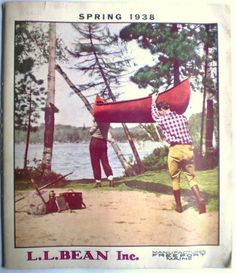
The Whole Earth Catalog provided channels through which self-sustaining systems could flow. Its models were, visually and practically, magazines such as the LL Bean Catalog (established in 1917, which gave access to information about products from hunting boots to fishing tackle) and the Seers Roebuck and Co. Catalog “the cheapest supply house on Earth” (established 1893). These publications were characterised by a simple description of a product with the minimum of editorialising.[29]
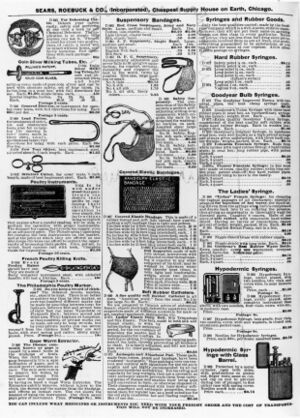
Brand envisioned a “catalog of goods which owed nothing to the supplier and everything to the consumer.” [30] The Whole Earth Catalog contained a list of items and information “where to buy a windmill. Where to get good information on beekeeping. Where to lay your hands on a computer.” [31]

The Whole Earth Catalogue spoke to a new post-war subjectivity, in which alternative, appropriate localised technologies are worked with “hands-on”. So rather than preach a position, the Whole Earth Catalog presented a complete discourse in which environmentalism, consumerism, individual choice and technology were bound together. This was within a culture of thrift and ingenuity which encourages self-responsibility and agency.
It was within this context of self-sustaining ecological living, in which – to paraphrase Marshall McLuhan – each technological development represents and extension of human potential, that cybernetic ideas of ecology were built into the structure of the counterculture of the 1960s.[32] In a cybernetic system each element of that system is mediative, the subject can never be outside mediation.
.
Stewart Brand studied biology at Stanford University in the late 1950s. There he encountered systems orientated ways of thinking in relation to biology and ecology . His teacher was Paul Ehrlich, who described biological systems as “a complex energy-matter nexus.”
Ehrlich emphasised how elements within a system are engaged in a constant exchange of information, which affords adaptation by directing the flow of energy within that system. Ehrlich extended this cybernetic reading of biological systems further, for Ehrlich humans had reached a point where they could influence their biological development, at which point cultural engagement in the fields of politics, art and conservation become important to evolutionary development.
[34] In 1958, Brand wrote in his diary: ““the responsibility of evolution is on each individual man, as for no other species. Since the business of evolution for man has gone over to the mental and psychological phase, each person may contribute and influence the heritage of the species.” [35]
After graduation Brand was drafted into the army and served as an infantryman for two years. Whilst working as photographer, stationed at Fort Dix in New Jersey, Brand Brand spent his weekends with his friend, the painter Steve Durkee, in his lower Manhattan loft. Here Brand encountered a group of artists – including musician John Cage, painter Robert Rauschenberg, and performance artist Allan Kaprow– who blurred the boundaries between art and life. As early as 1952, at Black Mountain College in North Carolina, Cage and Rauschenberg had organised one the first “happenings”
[36]. In Theatre Piece No. 1 Merce Cunningham danced, M. C. Richards read poetry, David Tudor played the piano, whilst Cage gave a lecture; [37] They proposed a form of art in which the dividing line between the artist, artwork and audience is erased. [38]
In 1963 Steve Durkee, with poet Gerd Stern and sound engineer Michael Callahan, established USCO – an artists’ community in an old Methodist church in Garnerville in Upstate New York.[39]
USCO became a testing ground for methods of art-making and communal living. The “systems”, multi-media approach to art involved newly coined rituals (performances) mediated by strobe lights, light projectors, tape decks, stereo speakers and slide shows. These media served as technologies of self, along with marijuana and peyote and LSD, which augmented the senses.
It was at USCO that Brand encountered the works of Norbert Wiener, Marshall McLuhan, and Buckminster Fuller alongside the writings of Indian scholar Ananda K. Coomeraswamy. Coomeraswamy emphasised the traditional role of tribal living and collective craftsmanship which could be observed in many non-occidental societies.[40]
This ecological aesthetic did not involve a rejection of technology but an acceptance of the technologies of non-western cultures which served to enhance ecological and communitarian cohesion. In this sense the counterculture took an approach similar to structural anthropologists – the structures of non-western cultures could be applied to their own experimental culture (cohesion is maintained through the circulation of knowledge through the community). Fred Turner has termed the USCO performances “theatrical ecologies”, they take the on board the cybernetic notion that the individual is a part of a larger environment. This striving for social unity was reflected in the titles of USCO’s multimedia pieces: Who R U? and We R All One,”. [41]
For several years USCO served as a base as Brand travelled back and forth across America visiting the sites in which a new communitarian counterculture was emerging. Brand also stayed close to the technological developments within the research cultures of Stanford University and the San Fransisco valley (which would later become Silicon Valley) and visited the reservations of Native Americans. [42]
Brand’s early career describes the contours the emerging counterculture: at Stanford he encountered a vision of ecological unity based on cybernetics; in New York, and at the art commune USCO, he encountered a form of “systems art” which was philosophically close to cybernetics from an ecological and technological perspective. Brand went on to encounter at first hand a nescient communitarianism which understood organic unity in cybernetic terms and used cybernetic technologies of self as forms of collective and individual expression. [43]
It was into this culture that Radical Software was born. Within the broader counterculture community, video emerged as a technology of self, amongst a repertoire of other technologies which situated the self within a broader media ecology. Art was understood to be a part of life, and central to this new conception was a recognition of the self’s relation to a wider context. This new artistic vision, which binds together, cybernetics, ecology and self-reflexivity can be traced back to the Macy conferences on cybernetics. The rise of the artistic-communitarian project USCO was part of a broader debate which developed through the 1950s, a debate which Gregory Bateson was central to.
GREGORY BATESON - TOWARD A (MEDIA) ECOLOGY
Gregory Bateson's ideas, which crossed between ecology and media ecology, were seminal in the development of video art in the late 1960s and early 1970s. Bateson had been a prominent and active voice in debates about art and society throughout the 1950s[44] which shifted emphasis away from the artistic product (the painting or sculpture) and toward the context in which such an object is created. Central to Bateson's cybernetic aesthetics was self-reflexivity (by the artist and the audience of art) as a condition of artistic production. In 1957 Bateson and Marcel Duchamp joined Frank Lloyd Wright and Mayer Shapiro at the American Federation of Arts Conference. It was here that Bateson outlined a (media) ecological understanding of art. Schipiro represented the old-guard, regarding painting's foremost virtue to be its fundamental opposition to mass media, a view which was opposed by Bateson and Duchamp.[45] Duchamp delivered his now famous paper The Creative Act with Bateson presenting a text entitled Creative Imagination which was later published in STEM.[46]
The 1957 conference was noteworthy because it attracted a much larger audience than expected and because there was an insistence from those presenting, and the audience to discuss communication systems in relation to the arts. This was in the wake of an increased mass media presence and as the discourse on cybernetics became accessible to more people through (for instance) Norbert Wiener's books, a popularisation of Claude Shannon’s Information Theory as well as Bateson's own writing, including Communication and the Social Matrix of Psychiatry (with Jurgen Ruesch). Duchamp's paper sidesteps Schipiro's conservative position and holds the communicative and medial nature of art to be beyond the intention of the artist. The public decodes or "deciphers" the intentions of the artist and in so doing become creators of it.[47]
Bateson's paper is more assuredly cybernetic in nature. The Creative Imagination addresses the particular nature of artistic communication, which, as opposed to everyday communication, is a means of meta-level communication, art for Bateson is inherently self-reflexive, it communicates about communication. If Schipiro was interested in art as a form of resistance, or bulwark, to communication, a space immune from the perennial effects of communication, Bateson sees art as a play between different levels of communication, a play which makes those different levels visible.[48].
This position would be the central tenet of early video art and the media theory discussed in Radical Software and would be a formative influence on artists such as Dan Graham (profoundly influenced by Bateson and Radical Software). For Bateson, aesthetic awareness allows for an understanding of the process by which it is possible to acquire knowledge. This produces the grounds on which a communications system is framed to be made visible, which for a generation of artists in the 1960s and 70s situated art as an inherently self-reflexive, self-critical and context-critical endeavour. For Bateson communication produces context and further reflection on the production of that context.[49]
This medial reading of aesthetics is in line with the valorization of creativity which was part of the post WWII's reinvention of the liberal subject: the self-reflexive self, constituted within media circuits (media-ecologies), which Bateson and Ruesch's Communication and the Social Matrix of Psychiatry had concerned itself. Here the self is beyond the individual subjectivity of ‘I’, mind is "immanent in the larger system, man plus environment. Communication is the "substance of common being".[50] Central to Bateson’s understanding of art was a conception of aesthetics as a form of ‘deutero-learning’ which deals with “context and classes of context” (as opposed to proto-learning which deals with “narrow fact”).[51]
When artistic practice and discourse finally adopted ideas of self-reflexivity and radical mediality in the late 1960s and early 1970s it was largely because of the influence Bateson had exacted on the counterculture from the 1960s on. Bateson’s vision of 'mind' as unbounded within a field of technological communication found resonance with a generation raised on the mass media and had also felt the alienating affects of that media. Many had also experienced some dissolution of the essential self through exposure to hallucinogenics, which provided a model demonstration of a self which is medial and co-exensive Gregory Bateson himself had been a participant in the CIA’s LSD experiments in the 1950s. The drug was administered to him by CIA agent Harold Abramson. In 1959 Bateson helped arrange for his friend, the beat poet Allen Ginsberg, to take the drug at a research program located off the Stanford campus (see chapter E-Meter).[52] This was the same programme at which Ken Keasy and Stuart Brand met. Keasy and Brand went on to organise the multi-media Trips Festival in 1966. [53] In the following year Kesey and his Merry Pranksters boarded the magic bus and in 1969 Brand (a semi-detached merry prankster) founded the Whole Earth Catalog.[54]
The attitudes and practices of the 1060s counterculture were extended and re-coded into self-sufficient media ecologies as the 1970s approached, flowing through the output of media groups such as Raindance, TVTV (Top Value TeleVision), Ant Farm, The Woodstock Community Video and Videofreex.[55] In the era of second-order cybernetics the emphasis was on experiments in technologies of self – re-programming the system, programming the community. In the 1970s the "access to tools" was still an essential concern, along with an insistence that media should be aid cultural cohesion.
Within this context the conflated term ‘media ecology’ was developed in the pages of Radical Software in the early 1970s. Arlo Raymond attempted a definition in issue 1. Media ecology was, for him: :”the study of media and communications and its affect on media and society.”[56] In STEM, Bateson took a more radical position, within a media ecology there is no distinction among technology, affect, and sociability.[57]


RADICAL SOFTWARE - TOWARD A (MEDIA) ECOLOGY
The Raindance Corporation was established as a platform for media activism, users of new video technology and as a "think tank" – a radical alternative to the RAND Corporation.[58] Radical Software, which became the editorial outlet for Raindance, was founded by Beryl Korot, Phyllis Gershuny, and Ira Schneider.[59]
It provided a forum for discussion, the decimation of information and the formulation of media theory as well as a platform for established writers and theorists. The founders and contributors to Radical Software were largely artists working with the new Portapak video system which became accessible at the end of the 1960s. At the cost of $1495 it was not cheap, but it was in the range of many more users than had previously been the case, and could be easily acquired by collectives. Tapes were easy to distribute, and could be re-used and copied. The second technological revolution came in the form of cable (CATV). Ralph Lee Smith’s article The Wired Nation (1970) heralded a new media revolution which would accord access to the contact of “newspapers, mail service, banking and shopping facilities, data from libraries and other storage centres, school curricula and other forms of information too numerous to specify. In short, every home and office will contain a communications centre of a breadth and flexibility to influence every aspect of private and community life.”[60] The artists Frank Gillette and Ira Schnider, in the first issue of Radical Software (1970), recognised that the combination of cable hooked up to portable video equipment would break the ecology of the mass media, radically changing the subject positions of producers and consumers of media.[61] CATV, like CCTV, was a closed circuit system extended to a very great extent allowing for a feedback loop of communication between participants over a great distances.[62] The recursive structure of this system could take the form of shared communication and could equally create positive feedback (noise). Both feedback as noise and negative feedback as a system of control offered political and artistic potential which the community around Radical Software were keen to exploit.
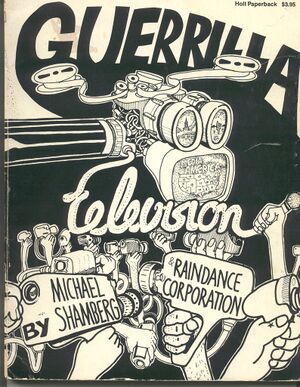
Raindance and Michael Shemberg’s publication Guerrilla Television (with graphics by architect-design collective Antfarm) (1971) would identify mainstream ‘Media America’ as designed to minimise such feedback, allowing only a one-way flow between sender and receiver. This resulted in an accumulation of cultural power into the hands of corporate America. Portable video systems, along with access to cable technology, would help redress this imbalance. A principle platform in the pages of Radical Software, therefore, was to lobby for the open uses of CATV (the appointment of licences began in 1970). Between 1968 and 1972 cable operators offered support to community based projects, this was exploited by a wave of artist-activist initiatives and underwritten by New York State Council for the Arts (which in 1970 increased its budget to the arts from $2m to $20m). Initiatives by artists and artist collectives also received support from private foundations. The emphasis and motivation on the community of video artists working for and around Radical Software was on community based media projects and ecological activist projects (the annual Earth Day began in 1970). [63] Paul Ryan had worked for Marshall McLuhan whilst McLuhan was visiting professor at Fordam University (1967-1968). McLuhan gave Ryan, Frank Gillette and Nam June Paik access to Sony Portapaks that McLuhan had received from from Sony (he had little practical use for them). [64]

Ryan and Gillette, along with their colleague Roy Skodnick [65] would become key architects in the discourse of video-art-activism as it emerged from the ecological movement. They produced seminal works, texts and forums for theory and practice (often through the offices of Raindance and Radical Software). Radical software combined pragmatic advice of how to work the technology with an emergent theoretical framework which considered the implications of that technology on future culture and society.[66] Ryan was inspired by McLuhan at his most optimistic, who in Understanding Media, had posited that electronic media could result in “the ultimate harmony of all being” [67], this, in Radical Software was tempered with a politically critical approach which advocated “Cybernetic Guerrilla Warfare”[68] which challenged the "top down" monopolies of Media America.
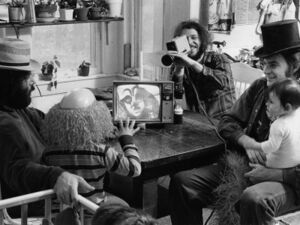
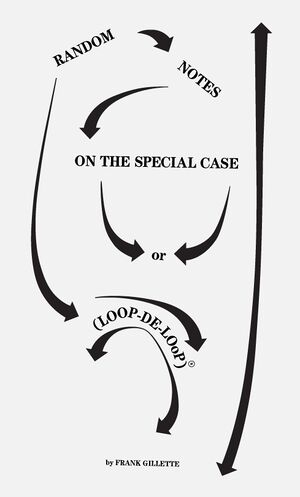

If the Portapak as a piece of technology encouraged a radical new form of social-media and media collectivity, it also allowed for the creation of artworks which made the individuals place within a media circuitry visible. Paul Ryan’s Everyman’s Mobius Strip (1969), Frank Gillette and Ira Scheider’s Wipe Cycle (1968),and Dan Graham’s TV Camera/ Monitor Performance (1971); Frank Gillette’s, Video: Process and Meta-Process (1973) all performed the logic of the self as co-extensive to a given system =(nervous system, system, environment). As Skodnick was to reflect years later, social movements and media movements were converging “[…] with Bateson as principle guide to the complexities of nature and culture. [Frank] Gillette did it, Randy Sherman did it, and apparently [Dan] Graham did it too. Anyone who happened to get hold of a portable video system at the time immediately overloaded on circuits, playback, feedback and fabulous loop de loop.” [69]The Porta Pak, Skodnick observed, was a “beautiful system” that not only allowed the user to “ track social behaviour but also to see how social behaviour is framed […] TV dissolved into a more plastic language.” Skodnick continues, “ [T]here was a full-bore media war of information then, and visual information was fully up for grabs. We could put ourselves in it, see ourselves seeing ourselves, and even enter the jouster with the ‘News cycle’ emptying out, as was demonstrated in [Gillette’s] Wipe Cycle.” Such was the “radical ecology of Radical Software”. [70] Paul Ryan: “Video itself mutated from a counter cultural gesture to an art genre. When video was principally a countercultural gesture, it held the promise of social change unmediated by the art world. Now, whatever promise of social change video holds is mediated by the art world. This is a significant difference. People unfamiliar with the mutation find it difficult to appreciate the unlimited sense of possibility that early video held.” It was in this milieu that Bateson's ideas made their transition from the sphere of ecology into media art. For Bateson, in the realms of anthropology, psychiatry, ecology and aesthetics the self-reflexive subject is central, the medial subject who recognises their place within a hierarchy of abstraction The progression from Behaviour, Teleology & Purpose, the McCulloch-Pitts model, Norbert Wiener’s negentropy and, Ashby’s Homeostat to the emerging ecology movement and its abiding connection to media ecology can be found in Bateson's 1968 essays Effects of Conscious Purpose and Human Adaptation [71] and The Roots of Ecological Crisis[72].[discussed in the previous chapter] In these Bateson returns to the beginning of the fabulous loop de loop, and to the evolutionary models that had excited Samual Butler's imagination a century before, to the 'vapour engine' which, even on this side of the fabulous loop de loop, serves again as a model for evolution.
- ↑ This section of the text is an annotation of Peter Sachs Collopy's text. I function here more as an editor than a writer. For a more thorough and precise reading see: Peter Sachs Collopy, The Revolution Will Be Videotaped: Making a Technology of Consciousness in the Long 1960s. University of Pennsylvania, 2015. p50-93
- ↑ Peter Sachs Collopy, The Revolution Will Be Videotaped: Making a Technology of Consciousness in the Long 1960s. University of Pennsylvania, 2015. p50
- ↑ Peter Sachs Collopy, The Revolution Will Be Videotaped: Making a Technology of Consciousness in the Long 1960s University of Pennsylvania, 2015. p74
- ↑ (which mounted four heads on a drum which scanned the two inches-wide tape as well as its length,
- ↑ Peter Sachs Collopy, The Revolution Will Be Videotaped: Making a Technology of Consciousness in the Long 1960s. University of Pennsylvania, 2015. p75
- ↑ Peter Sachs Collopy:“[The Ampex] VR-1000, for example, weighed 1465 pounds and cost $45,000 in 1956”. Peter Sachs Collopy, The Revolution Will Be Videotaped: Making a Technology of Consciousness in the Long 1960s. University of Pennsylvania, 2015. p77
- ↑ Peter Sachs Collopy, The Revolution Will Be Videotaped: Making a Technology of Consciousness in the Long 1960s. p56
- ↑ Peter Sachs Collopy, “Ampex trademarked the word Videotape and sold recorders ‘to all major telecasting networks, and to many network-affiliate and independent TV station in the U.S. and several foreign countries,’ including Canada, Japan, England, and Germany by 1958 and another 23 by 1961” Peter Sachs Collopy, Peter Sachs Collopy, The Revolution Will Be Videotaped: Making a Technology of Consciousness in the Long 1960s. University of Pennsylvania, 2015. Sachs Collopy Cites: Ampex, 1958 Annual Report, box 16, series 2, Ampex Corporation Records, pp. 9, 26; Ampex Corporation, 1961 Annual Report, box 16, series 2, Ampex Corporation Records, p. 13
- ↑ Peter Sachs Collopy, The Revolution Will Be Videotaped: Making a Technology of Consciousness in the Long 1960s. University of Pennsylvania, 2015 p79
- ↑ Peter Sachs Collopy, The Revolution Will Be Videotaped: Making a Technology of Consciousness in the Long 1960s. University of Pennsylvania, 2015 p 80
- ↑ Peter Sachs Collopy, The Revolution Will Be Videotaped: Making a Technology of Consciousness in the Long 1960s. University of Pennsylvania, 2015 p 81
- ↑ Peter Sachs Collopy, The Revolution Will Be Videotaped: Making a Technology of Consciousness in the Long 1960s. University of Pennsylvania, 2015 p 83
- ↑ Ampex, 1963 Annual Report, 7.In Peter Sachs Collopy, The Revolution Will Be Videotaped: Making a Technology of Consciousness in the Long 1960s. University of Pennsylvania, 2015 p.84
- ↑ Peter Sachs Collopy, The Revolution Will Be Videotaped: Making a Technology of Consciousness in the Long 1960s. University of Pennsylvania, 2015 p.84 (By now the system used the half-inch CV [consumer video] format which used the hexical scan and the “frame rate” was reduced through a “skip field” function.)
- ↑ See chapter – The Tortoise and Homeostasis
- ↑ Peter Sachs Collopy, The Revolution Will Be Videotaped: Making a Technology of Consciousness in the Long 1960s. University of Pennsylvania, 2015 p93
- ↑ the year after publishing Communication the Matrix of Psychiatry
- ↑ in rev videotaped
- ↑ Ray L. Birdwhistell,“Contribution of Linguistic-Kinesic Studies to the Understanding of Schizophrenia,” in Schizophrenia: An Integrated Approach, ed. Alfred Auerback (New York: Ronald Press, 1959), 101.
- ↑ In Toward a Theory of Schizophrenia: “[…]we must expect a pathology to occur in the human organism when certain formal patterns of the breaching [of levels of abstraction] occur in the communication between mother and child”p.1[…] This point is qualified later in the paper: “We do not assume that the double bind is inflicted by the mother alone, but that it may be done either by mother alone or by some combinations of mother, father, and/or siblings.” p3, in Gregory Bateson, Don D. Jackson, Jay Haley, and John Weakland, Toward a Theory of Schizophrenia, Veterans Administration Hospital, Palo Alto, California; and Stanford University, Behavioral Science 1(4): 1956 pp.251-254
- ↑ Gregory Bateson, Don D. Jackson, Jay Haley, and John Weakland, Toward a Theory of Schizophrenia, Veterans Administration Hospital, Palo Alto, California; and Stanford University, 1956 p1
- ↑ Gregory Bateson, Don D. Jackson, Jay Haley, and John Weakland, Toward a Theory of Schizophrenia, Veterans Administration Hospital, Palo Alto, California; and Stanford University, 1956 p.3
- ↑ Toward a Theory of Schizophrenia, p.1
- ↑ Gregory Bateson, Don D. Jackson, Jay Haley, and John Weakland, Toward a Theory of Schizophrenia, Veterans Administration Hospital, Palo Alto, California; and Stanford University, 1956 p.3
- ↑ (This notion of the label brings us back to the structural differential. You may remember that K used labels which denoted different levels of abstraction deriving from the “object event”).
- ↑ Videotape Techniques in PsychiatricTraining and Treatment, ed. Milton M. Berger (New York: Brunner/Mazel, 1970),
- ↑ Milton Berger, “Multiple Image Self Confrontation,” Radical Software 2, no. 4 (Fall 1973): p.8.
- ↑ Gregory Bateson Radical Software Issue 5 Volume 1, 33 3Bateson STEM. 87
- ↑ Having said that, the politics of many of the contributors tended toward a libertarian distrust of big government [Andrew G. Kirk Counterculture Green: The Whole Earth Catalog and American Environmentalism; University Press Kansas, 2007, p 21] and the contrast between the New left, (which fought for institutional reform) and the counterculture (which advocated individualism and a withdrawal from institutional politics) is substantial. See alsoFred Turner From Counterculture to Cyberculture
- ↑ Brand in Andrew G. Kirk Counterculture Green: The Whole Earth Catalog and American Environmentalism; University Press Kansas, 2007, p1
- ↑ J. Baldwin The Essential Whole Earth Catalog | cited in Andrew G. Kirk: Counterculture Green: The Whole Earth Catalog and American Environmentalism; University Press Kansas, 2007, p 21
- ↑ Understanding Media | McLuhan's medium theory was influenced by Bateson's Communication and the Matrix of Psychiatry and Wiener's Cybernetics
- ↑ Paul Ehrlich and Richard Holm, Process of Evolution, viii, 1963, 19. This statement reflects the degree to which cybernetics and information theory had influenced the teaching of biology by the end of the 1950s. Ehrlich later became famous for his book The Population Bomb (1968) which warned against ecological disaster as a result of over-population
- ↑ Fred Turner From Counterculture to Cyberculture p44
- ↑ Fred Turner From Counterculture to Cyberculture p45
- ↑ A term coined in 1958 by Allan Kaprow
- ↑ Note:Kaprow and Cage had both studied at the New School for Social Research (where Bateson was amongst the staff).
- ↑ In such instances sensitivity is amplified by mediative technologies which alter the consciousness of the participants.
- ↑ USCO stands for US Company, punning on the corporate an colligate senses of “company”
- ↑ Counterculture to Cyberculture
- ↑ turner p.51; Note: In this culture technologies of self were accompanied by an interest in mysticism which opposed the uniformity found in culture of the “company man” in the West, which mirrored by the uniformity of the communist party member of the Soviet Block.
- ↑ Bootstrapping, Engelbard
- ↑ Counterculture Green; Counterculture to Cyberculture
- ↑ For instance, Bateson was a member of the Western Roundtable on Modern Art in San Francisco in 1949, which included Marcel Duchamp.
- ↑ William Kaizen, Steps to an Ecology of Communication: Radical Software, Dan Graham, and the Legacy of Gregory Bateson: Art Journal, Vol. 67, No. 3 (FALL 2008), pp. 86-107, p92
- ↑ M.Duchamp The Creative Act, ART-news Vol. 56, no. 4, 1957
- ↑ M.Duchamp The Creative Act, ART-news Vol. 56, no. 4, 1957
- ↑ Gregory Bateson The Creative Imagination Stem p
- ↑ William Kaizen, Steps to an Ecology of Communication: Radical Software, Dan Graham, and the Legacy of Gregory Bateson: Art Journal, Vol. 67, No. 3 (FALL 2008), pp. 86-107 pp. 93-94
- ↑ Bateson, in William Kaizen, Steps to an Ecology of Communication: Radical Software, Dan Graham, and the Legacy of Gregory Bateson: Art Journal, Vol. 67, No. 3 (FALL 2008), pp. 86-107, p94
- ↑ Bateson, Mind and Nature, 156
- ↑ Marks 1979:120
- ↑ Turner; From Counterculture to Cyberculture, University of Chicago Press, 2008
- ↑ Bateson, through his friendship with Alan Watts, also took an interest in Zen Buddhism as the model for a non-occidental, radically discentered, non-Cartesian philosophy STEVE P. HEIMS: Journal of the History of the Behavioral Sciences 13 ; GREGORY BATESON AND THE MATHEMATICIANS: FROM INTERDISCIPLINARY INTERACTION TO SOCIETAL FUNCTIONS 1977, 141-159
- ↑ David Joselit Feedback: Television Against Democracy, MIT Press 2007
- ↑ Arlo Raymond, Media Ecology Radical Software Issue 1
- ↑ Bateson STEM. 87
- ↑ The Research ANd Development arm of the industrial, military, academic complex)
- ↑ All past issues are archived here https://www.radicalsoftware.org/e/index.html
- ↑ Lee Smith, in Joselit's Feedback, Television Against Democracy, MIT, 2007 p91
- ↑ Radical Software, Issue 1. 1970
- ↑ David Joselit's Feedback, Television Against Democracy, MIT, 2007 pp 96-97
- ↑ David Joselit Feedback, Television Against Democracy, MIT, 2007 p98
- ↑ P. Ryan; A Genealogy of Video; Leonardo, Vol. 21, No. 1, 1988, pp. 39-44
- ↑ – nicknamed the “Bateson Boys” because of their fondness for Bateson’s theories
- ↑ Paul Ryan, Radical Software issue 4, 1971.
- ↑ McLuhanUnderstanding Media
- ↑ Paul Ryan, Radical Software Issue 4
- ↑ Skodnick: Radical Software and the Legacy of Gregory Bateson Author(s): Paul Ryan and Roy Skodnick; Art Journal, Vol. 68, No. 1 (SPRING 2009), 113
- ↑ Skodnick Radical Software and the Legacy of Gregory Bateson Author(s): Paul Ryan and Roy Skodnick: Art Journal, Vol. 68, No. 1 (SPRING 2009),113
- ↑ Bateson,StEM 446
- ↑ Bateson StEM 494